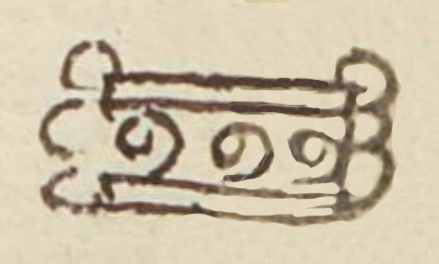Tetlacuilol (MH489r)
This black-line drawing of the compound glyph for the personal name (or occupational designation) Tetlacuilol may mean carved stone. The name is attested here as male. It contains two merged elements. One is the stone (tetl), which is shown horizontally with curlicue ends. The other is a piece of writing or a design (what we are assuming to be tlacuilolli), also horizontal and fit onto the stone. It has horizontal lines at top and bottom, plus three curling or swirling lines in a row along this horizontal space.
Stephanie Wood
The swirls that represent writing or a design on the carved stone of this glyph are vaguely reminiscent of speech scrolls. They also recall the symbols on the piece of writing being made by the pintor/tlacuilo in the Codex Mendoza. Since the companion gloss for the glyph in this record is cut off, and we cannot be sure how it would end, this glyph might have been intended to read as Tetlacuilo. But, we have yet to find another glyph for Tetlacuilo, and glyphs for Tetlacuilol are very prevalent in the Matrícula de Huexotzinco.
Marc Thouvenot identifies the verb icuiloa (or ihcuiloa, with the glottal stop), which means to paint, write, or print, as having a root of -cuil-. He notes how it also appears in tlacuiloliztli (writing), tlacuilo (writer), and cuicuiltic (mottled). He goes on to show various uses of icuiloa that take it beyond the simple definitions just given, resulting in something like the action of creating a design (e.g., on leather, ceramics, sculpture, or in textiles). It can also be something like the action of decorating (e.g., to put a flower on a cup of atole). He associates icuiloa and tlacuilolli with "cultural artifacts," such as arts and crafts or examples of writing and painting, but cuicuiltic with effects created by "nature." This short summary barely does his article justice; it is worth reading the entire piece. How Thouvenot's study might connect with the concept of bent or curved mentioned by Prem (1974: 555, 682) raises an interesting question. Perhaps the bent or curved lines of writing, painting, carving, embroidery, and so on, fall with in the realm of expressions of -cuil-. See
Marc Thouvenot, "Imágenes y escritura entre los nahuas del inicio del XVI," Estudios de Cultural Náhuatl 41 (2010).
Stephanie Wood
diego tetlacu...
Diego Tetlacu[ilolli] or Diego Tetlacuilo
Stephanie Wood
1560
Stephanie Wood
writings, escrituras, stones, piedras, writers, escritores, pintores, escultores, sculptors

te(tl), stone, https://nahuatl.wired-humanities.org/content/tetl
tetlacuilo, sculptor, https://nahuatl.wired-humanities.org/content/tetlacuilo
tlacuilol(li), a piece of writing, a painting, or a design, https://nahuatl.wired-humanities.org/content/tlacuilolli
Escritura en Piedra
Matrícula de Huexotzinco, folio 489r, World Digital Library. https://www.loc.gov/resource/gdcwdl.wdl_15282/?sp=57&st=image
This manuscript is hosted by the Library of Congress and the World Digital Library; used here with the Creative Commons, “Attribution-NonCommercial-ShareAlike 3.0 License” (CC-BY-NC-SAq 3.0)










